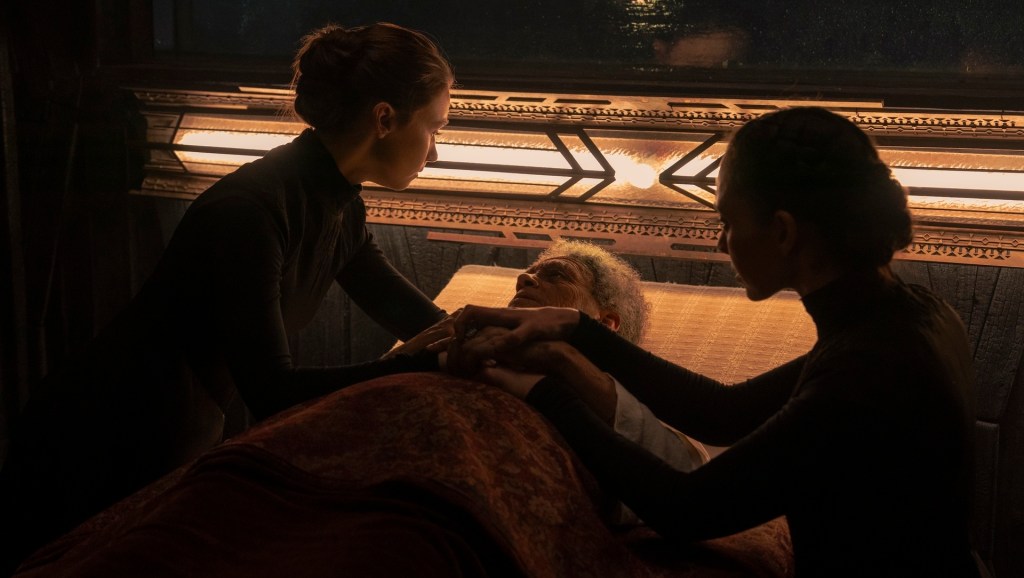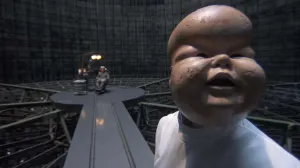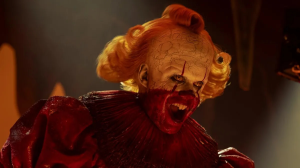Dune Prophecy starts with an allusion to the series’ later, more esoteric material, particularly the novel God Emperor of Dune. Fans were ecstatic to see this Easter egg – especially since filmmaker Denis Villeneuve does not intend to go that far in his adaptation. Read on for a bit about this hint you may have missed, but fair warning: there are spoilers ahead!
Videos by ComicBook.com
In the opening minutes of Dune Prophecy, we get a massive exposition dump by Valya Harkonnen (Emily Watson), which culminates in the scene where a younger Valya (Jessica Barden) assumes control of The Sisterhood. Valya is chosen for leadership by her predecessor, Mother Superior Raquella Berto-Anirul (Cathy Tyson), and we see that the sisters all revere Raquella. It’s also implied that Raquella has some form of prescience, as she has a vision on her deathbed and her followers all take it as an omen.
“Red dust… Red… It’s coming. Tiran-Arafel,” Raquella said to Valya in her final moments. Later, Valya repeats the phrase in a secret conversation with other sisters. She says: “She warned us. Tiran-Arafel.” Sister Kasha (Yerin Ha) elaborates: “A reckoning. A holy judgement brought on by a tyrant.”
“From what I saw in Raquella’s eyes, I believe one is coming for us,” Valya concludes. This is the impetus for the entire story to follow, and it’s a strong reference to events that come much later in Herbert’s novels. “The Tyrant” is a title the Bene Gesserit later reserve for God Emperor Leto Adreides II, and as YouTuber Quinn’s Ideas pointed out, “arafel” is one of Leto II’s final words.
“Do not fear the Ixians. They can make the machines, but they can no longer make arafel. I know. I was there,” the God Emperor says on his death bed in the 1981 novel.

The Tyrant
As we saw in Dune, the Bene Gesserit are on a long-term mission to breed the perfect ruler, but are wary of empowering the wrong person – which is why Lady Jessica is shunned for training her son Paul Atreides to become the “Kwisatz Haderach.” However, in Herbert’s novels Paul ultimately falls short of this power, while his son Leto II grasps it instead. Leto merges with a colony of sandtrout and transforms into a version of a sandworm himself. The process extends his life by thousands of years, and he rules over the Imperium with an iron fist for all that time – to the dismay of the Bene Gesserit, among others.
Ultimately, the reader understands that Leto is not evil and is doing what’s best for the human race, but no one around him can see with the same clarity he has. That means even the Bene Gesserit see him as “The Tyrant” – before, during, and after his reign. It’s a part of the God Emperor’s grand design to be seen this way, which means Raquella really is getting a glimpse of the distant future.
Tiran-Arafel
Arafel is a Hebrew word from the Bible, which means “fog” or “mist.” In God Emperor of Dune, Herbert elaborates that in his context, it means “cloud-darkness of holy judgement.” The addition of “tiran” in Dune Prophecy indicates that this darkness is brought on by a tyrant.
Arafel is one of the many apocalyptic terms used in later Dune books, and like most of them it cannot be interpreted too literally. For one thing, it turns out to be a code Leto II is using to guide the Bene Gesserit to a hidden treasure after his death. For another, his goal is really to empower humanity to face the unknown, which includes clouds of darkness further out in the universe.
RELATED: Dune 3’s Plot Explained (And What It Means for the Series’ Future)
As for the quote’s mention of the Ixians, that’s a bit harder to summarize. While most of human society rejects advanced technology in the Dune universe, Ix is a planet where people push that boundary. With his dying words, Leto is essentially saying that humans are now free to experiment with technology again because he has taken steps to ensure that they will not fall back under the rule of artificial intelligence. That threat is even more relevant in the time of Dune Prophecy than in the main story.

Raquella’s Vision
The scene on Raquella’s deathbed shows us flashes of her vision – likely hints about the future of Dune Prophecy. we see a massive sandworm big enough to swallow a manmade palace whole, and glimpses of burnt flesh, blood and an odd throne. All of these may play out in the coming episodes, but they are also hints about the wars to come for humanity. The throne, in particular, could be made for a worm-like body rather than that of a human.
This may just be an Easter egg, but the references to later books indicate to the audience that Raquella is experience true prescience. That raises some questions about her powers as a “Mother Superior.” At this point in the books, the Sisterhood does not use the Spice Melange from Arrakis in its rituals, which means its leaders do not have prescient visions of the future. The show could easily change this, but so far none of the sisters – including Raquella – have been shown with blue eyes. However, her mentions of “red dust” could be a hint that she was consuming spice in small doses, or that the rest of the Sisterhood may be doing so soon.
Dune Prophecy airs on Sundays at 9 p.m. ET on HBO and Max. The novels are available in print, digital and audiobook formats.








